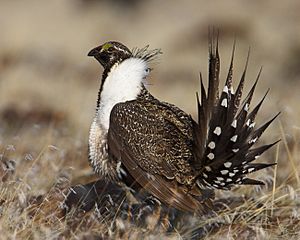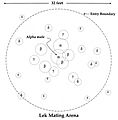Greater sage-grouse facts for kids
Quick facts for kids Greater sage-grouse |
|
|---|---|
 |
|
| Male in USA | |
| Conservation status | |
| Scientific classification | |
| Subspecies | |
|
|
 |
|
| Sage grouse range |
The greater sage-grouse (Centrocercus urophasianus) is the largest type of grouse found in North America. These birds live in the western part of the United States. You can also find them in the Alberta and Saskatchewan provinces of Canada. They are bigger than a pheasant but smaller than a wild turkey.
Greater sage-grouse belong to the Phasianidae family. Another bird, the Gunnison sage-grouse (Centrocercus minimus), is the only other species in the same bird group, or genus, as the greater sage-grouse.
Sage-Grouse Populations
Long ago, millions of greater sage-grouse lived across North America. Sadly, their numbers have dropped a lot. This is mainly because they have lost their sagebrush homes, called habitat. Now, there are only about 200,000 to 500,000 birds left in the western United States.
Because of this big drop, people are thinking about listing them under the Endangered Species Act (ESA). This law helps protect animals that are in danger. In Canada, it is thought that 90% of their living areas are gone. They have completely disappeared from British Columbia. Between 1988 and 2006, the number of sage-grouse in Canada went down by 88%.
Courtship and Reproduction
Every spring, male sage-grouse gather in special open areas called "leks." This is where they perform amazing courtship displays to attract females. As the males dance, they make a loud popping sound. They do this by inflating and deflating two bright yellow air sacs on their throats.
While they make these sounds, they also display their pointed tail feathers and strut around. Sometimes, as many as twelve males will dance at the same time. Occasionally, two males might even fight using their wings. The hens (female sage-grouse) watch these displays for several days. After watching, they choose a mate.
The females build their nests in the sagebrush plants. The male sage-grouse do not help with building nests or raising the chicks.
Images for kids
See also
 In Spanish: Urogallo de las artemisas para niños
In Spanish: Urogallo de las artemisas para niños




